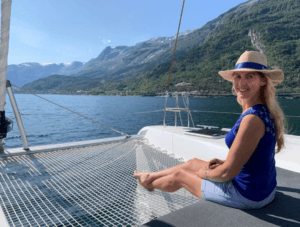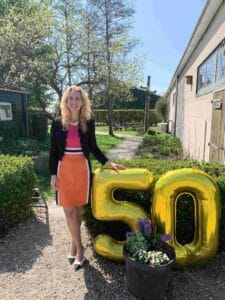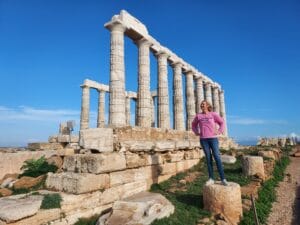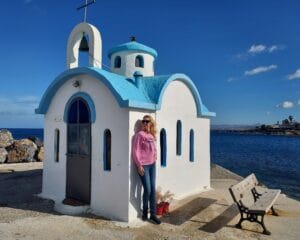When you have lived for 2 years surrounded by nature like we have, living on the water in our catamaran, you get to know and appreciate nature more and more. In fact, you become impressed by the environment around you. You experience life on and under the water, and you also see how vulnerable it sometimes is.
To be honest, our initial intentions to live with and from nature were first about cost-saving. Sailing is in fact using sun, water and wind that is provided to you every day and free of charge.
But more and more your understanding of those forces of nature begins to grow, and so are your admiration and gratitude. Then you also want to give back and care for nature more and more.
These are 10 things we do in sustainable sailing:
1. Sun energy for solar panels
We use the sunlight to transform to power for our boat. We do this also to avoid using shore power in harbors. Because that is based on the classic energy sources that are in the earth, made into fossil fuels, which is environmentally harmful to generate and also exhaustible. Sunlight is a clean energy source and inexhaustible.
We calculated that we need a maximum of 10 KW per day in case we have 4 guests on board, so for 6 people in total.
We need this electricity for our refrigerator, freezer, computers, TV, cooking, flushing the toilets, charging the cellphones, coffee and tea making, lights in the boat during the evening, microwave, boiler, heaters.
Sound familiar? It is 90% the same as in your house 😉. But I remember when I plugged into the socket at home to charge my phone, or start the microwave, I did this without thinking about where the energy came from. You learn, by living on a sailboat, that every second of your electricity consumption must first have been generated somehow before you can use it!
Our 10 KW maximum per day means we need 1700 watts of solar power. We bought 5 solar panels, each 340 Wp (Wattpeak) to reach that 1700 watts. We use LG bi-facial solar panels, they are transparent, so they can pick up the light from both sides: on top the direct sunlight and at on the other side of the panel facing the water, the panel picks up the reflection from the sun in the water.

We designed ourselves a stainless steel rack for 5 solar panels at the back of the boat. The solar rack is adaptable in an angle from 0 to 180 degrees, so we can choose the best angle to pick up the sunlight during daytime and optimize the power generation.
The solar panels are attached behind the boat, at the end of the roof and not on top of the roof, to create shade above our dinghy at the back of the boat, so UV will have less impact to help its longevity. Next to that, solar panels at the back of your boat is easier for maintenance and diving from the rooftop of the catamaran into the water 😉!
2. Lithium batteries
To transform all these Wattpeaks via the solar panels into power, you need an inverter, but more importantly, you need to be able to use solar power during the night and on cloudy days. So you need the possibility of storage of power and that’s why we bought lithium batteries.


We have collaborated with New Energy Today in Holland in this project: they helped us to install the Victron multiplus GX inverter connected to 4 MG HE Series lithium batteries, to provide a total of 15 KW of storage capacity.
We are very happy with our solar panels and lithium batteries, it gives us enough power, it makes use of the free and clean sun energy and is easy to generate, because we don’t have to go into expensive harbors to use their shorepower based on fossil fuels. Being self-sufficient gives you freedom and a feeling of pride in working with nature without burdening it!
3. Seawater turned into drinking water
Next to energy storage, you also have to have enough drinking water on board. Especially when you are crossing seas and oceans. For instance, when you cross the Atlantic ocean, you need drinking water for at least 3 weeks, because there are no or very few islands to get fresh water.
Our catamaran has 2 watertanks which each have a capacity of 300 liters. That will not be enough, when you make long trips across blue waters with a crew.
So we imported a watermaker from Seawater Pro, a specialized company in Fort Lauderdale, Florida and installed it in one of the engine rooms in our catamaran. The watermaker pumps sea water through a membrane at high pressure of about 800 Psi. For each liter of salt water, one can generate 100 ml of fresh drinking water. Our system can pump 1200 liters of sea water per hour through the membrane, to generate 120 liters of fresh water that hour.


The fresh water goes through 7 filters to remove chemicals, heavy metals, viruses and bacteria out of the water. The water that remains to use in our boat then, can easily be put in Evian’s mineral water bottles 😉.
Conclusion: we produce our own fresh water! To drink, shower, cook, etc.
The high pressure pump of the watermaker obviously uses a lot of power. But the great thing is, when you have enough solar power, it’s not only the fresh water made for sea water is clean energy, but because of the solar panels, also the power to make that fresh water is based on clean energy!
Again, not having to go into harbors to use their drinkwater, which is generated by fossil fuels, makes us self-sufficient which gives us freedom and pride to live from natural sources.
4. Sails and wind energy
Let’s talk about transportation, travelling from A to B, because usually that uses a lot of CO2 emissions (using cars, busses, planes, etc). We use wind energy to move our tiny house called sailboat 😉. We sold our cars in the Netherlands and do our travelling by wind energy. We considered a camper for our world trip, but that would use so much fossil fuels, and also be costly (petrol) and not very sportive in our experience. We want to do slow travel, appreciate the outdoors, fresh air, ‘work for it’ to get a sense of fulfillment after a day of sailing when you anchor in a bay.


Our ecological footprint is very low. You can even say: after 1 meter of travelling with your boat through the water, your footprint is literally not seen anymore, because the waves wash away your traces. I find it refreshing to live on the water of seas that have been there for millions of years. It makes you humble, our lives are nothing but a drop of water the oceans, you are very small on your boat compared to the Greatness of Mother Nature.
5. E-bike and e-step
Talking about transportation: we do our worldtrip on sails and solar and windenergy. Our boat is our car to travel on the water. But sometimes you want to travel by land, because there is also a lot of beauty to explore on land (think of woods, villages, etc). We use our electric bike and electric step to travel on land. We can travel with them for 60 kilometers per day. Not having to use buses or rent a car (powered by fossil fuels) is more sustainable. And of course you guessed it: to charge our e-bike and e-step, we use the solar power on our boat!


6. Ultra sonic anti fouling
We sail all year round, so our boat stays in the water all the time. But that causes algae, seaweed and shells to grow on your boat under the waterline. Especially in salt water. This accumulation slows down the sailing, disturbs the watercurrent and affects the material of your underwater hull. You need antifouling to protect your boat under the water, which is a paint. The most commonly used ‘self-sharpening’ antifouling paint comes off slowly during sailing and contains copper-containing biocides and zinc. Even when the boat is stationary, copper ends up in the water.
Our ship was build in June 2019, normally new antifouling is needed every year. Especially when you don’t lift the boat out of the water for a part of the season, because laying still in the water during wintertime makes the growth of algae, seaweed and shells to on your boat under the waterline even more easily. Because we keep on sailing, we were advised to have new antifouling paint every 1,5 or 2 years. But we want to prevent having to use the regular antifouling paint, because it’s toxic, expensive and requires planning and organization to have your catamaran lifted out of the water and treated (cleaning, priming, antifouling, etc) over a number of days.
Ultrasonic antifouling is the answer. These systems are specially designed to prevent the pollution caused by algae in areas under the waterline of the ship, seawater circuits, sea chests. These systems produce ultrasonic sound waves at certain frequencies that go beyond the hearing area of people. When we left of for our world trip, we installed the small sensors in the hulls. It’s a clean way to keep algae of the boat: they avoid the boat because of the ultra sonic sound.

When we had the boat lifted out of the water in June 2021 to do a first check after 2 years of sailing, we found out that the ultran sonic had done it’s work so well, that even the Yacht Services Company that we hired in Les Sables d’Ollone to check underwater ship and antifouling were surprised that it hardly affected the existing antifouling on the ship that was fitted there as standard!
So we trust in this innovation for the coming years and are happy to have bought it.
7. Separating waste
We separate our waste on the boat. We use special containers for paper/cardboard and plastic. Often in harbors there are different trashcans to put in the different kinds of waste. Really excellent that this exists! We expected this in Northern Europe (for instance Sweden), but also in Spain and France, it is common to separate waste. Here you see an example in Spain.


Also you see more and more attention to the environment in the yacht marinas. Even the combination of art and environment, for instance in the project of a fish made of plastic in which you can put your empty bottles.
8. Baking bread
We bake our own bread. Our bread maker is powered by our solar panel. This way we avoid to have to go to bakeries that run their business on fossil fuels for their ovens. And fresh baked bread also contains less chemicals. We use half of the baked bread for 2 or 3 days, and the other half goes into the freezer, otherwise the bread is spoiled. Also made us think about what is used in shelf-stable bread which can be kept for one month ….

9. Local food
When it comes to food during the day, we use mainly local food bought on markets. So no strawberries in winter for us, but buying food that is harvested and sold in the same season. The best way of supporting the local farmers is to buy straight from the farm or on local markets (often Tuesdays or Saterdays).

Especially in Portugal, France and Spain, there are great fish markets and fruit markets! You learn new spices and types of food and start cooking the local way. For instance, in Spain we ate a lot of pimientos de padron (sweet peppers), in Sweden we appreciated the local fish and shrimps, in France we learned the local dish mussels in curry sauce.
It enriches your local experience, you support local farmers and avoid the supermarkets that import a lot of food with transport powered by fossil fuels.
10. Re-use, re-cycle, repair, declutter and share
Being self-sufficient also means begin able to repair equipment and material aboard. Not buying new things when they are broken, but try to repair.
Or recycle for instance old or torn clothes into cleaning wipes.
And also living in a tiny house, means decluttering. I gave away a lot of my business clothes to my nieces or friends and hardly buy souvenirs (why need them on a ship??) or new clothes.
Sailors are also a community that share or exchange their stuff. We got fresh food from people in the boat behind us, because they would go back to their country for 2 weeks and didn’t want to throw away fruit and vegetables. Or an American sailor, that used polyurethane foam that he bought in a big tube, but didn’t need and gave it to us.
3 ideas for the future that we can improve
Of course, we are not 100% living on clean energy or have no Co2 emissions at all. When there is no wind or wind coming from the ‘wrong’ direction, we need to start the engines. Or if it’s cloudy and we need energy being in a bay, we have to start a generator. And sometimes it’s comfortable to be in a harbor with shorepower and their drink water, available immediately. And we cannot avoid to sometimes use a bus, rent a car or travel by plane.

When it comes to being more sustainable we have 3 plans for the future:
- We want to make more use of the sources that nature provides us. For instance, the propellors of our boat, when we need to use the engines can be used as hydro electric propellors. Or we can install wind turbines on our ship. So far we have avoided wind turbines, because of their noise, low low yield and we call them ‘finger choppers’, but it is certainly an option to explore further. Innovation continues.
- We want to eat less meat. We are already eating less meat than at home 2 years ago, by changing it for eating more vegetables, or fish. But still, we have to drop the amount of meat.
- We want to have zero CO2 emission. And that is impossible, because you sometimes have to start your engine or generator. But you can also look at it creativily like the TVshow ‘3opReis’ does: they compensate their CO2 emission. This is how they do that: https://www.bnnvara.nl/3opreis/artikelen/co2-neutraal-reizen. It means donating to organizations that plant trees or do ecofriendly projects or building clean energy systems. We are currently looking into this!






